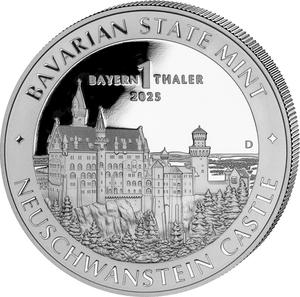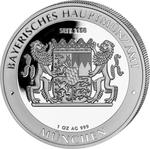
The obverse displays the full Coat of Arms of the Free State of Bavaria, one of the sixteen federal states that form the Federal Republic of Germany.
Supported by two lions, it is a quartered and crowned shield with a smaller shield at centre, as follows:
- in the first quarter (upper left): The Golden Lion which represents the administrative region of Upper Palatinate. It is identical to the coat of arms of the Electorate of the Palatinate.
- in the second quarter, The Franconian Rake which represents the administrative regions of Upper, Middle and Lower Franconia. This was the coat of arms of the prince bishops of Würzburg, who were also dukes of Franconia.
- in the third quarter, The Blue Panther which represents the regions of Lower and Upper Bavaria.
- in the fourth quarter, The Three Lions which represent Swabia.
- at centre, a white and blue "Inescutcheon" (in German, Herzschild = "Heart Shield") which was originally the coat of arms of the counts of Bogen, adopted in 1242 by the House of Wittelsbach. The white and blue fusils are indisputably the emblem of Bavaria and the "heart shield" today symbolizses Bavaria as a whole. Along with the People's Crown, it also forms part of the official minor or lesser coat of arms.
- The People's Crown: the shield is crowned with a golden band with precious stones decorated with five ornamental leaves. This crown appeared in the coat of arms for the first time in 1923 to symbolize the sovereignty of the people after the dropping out of the royal crown.
In small letters above the Coat of Arms, SEIT 1158 (since 1158) - the year when a mint was first established in Munich; around below in the inner circle, 1 OZ AG 999 (one troy ounce of 99.9% silver).
Around above, the inscription in German: BAYERISCHES HAUPTMÜZAMT (translated literally: Bavarian Main Mint). Around below, MÜNCHEN (Munich, the capital city of Bavaria where the mint is located). |





 Buy this online from BGASC.com
Buy this online from BGASC.com
 Buy this online from JM Bullion
Buy this online from JM Bullion
 Search for Germany: Silver Ounce Round 2025 Bavarian Thaler on eBay
Search for Germany: Silver Ounce Round 2025 Bavarian Thaler on eBay 
